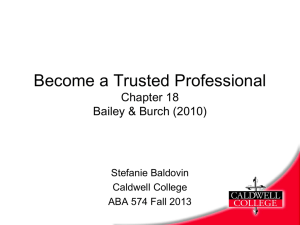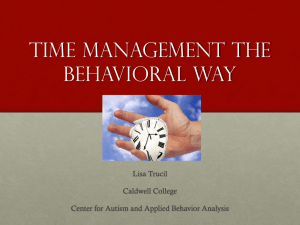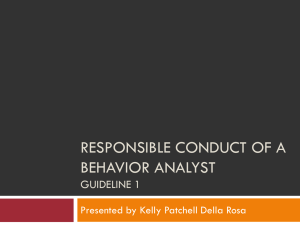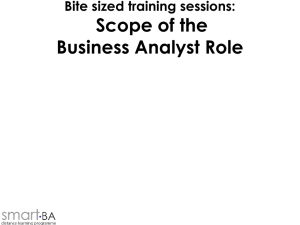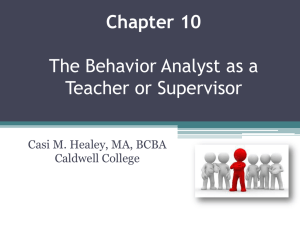Chap 15 Research Ethics
advertisement
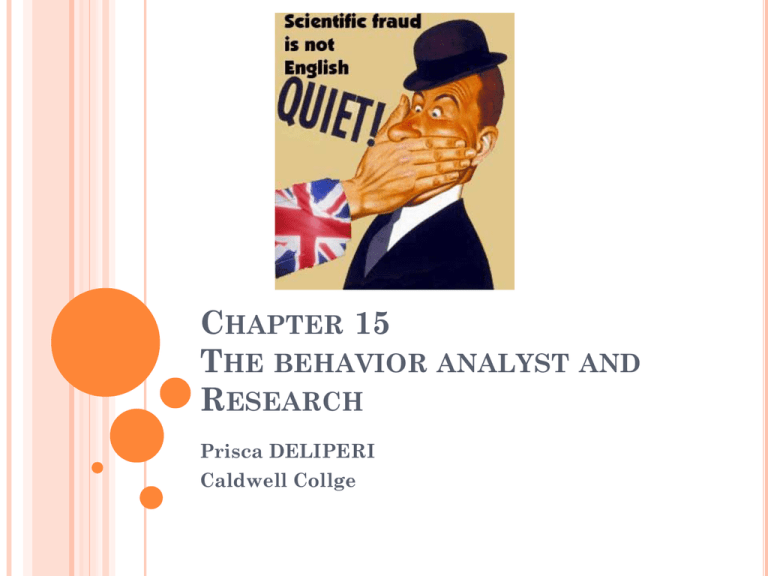
CHAPTER 15 THE BEHAVIOR ANALYST AND RESEARCH Prisca DELIPERI Caldwell Collge OVERVIEW Introduction Guidelines 10.0 to 10.24 Case studies Related code of ethics Questions References INTRODUCTION (BAILEY & BURCH, 2011) Conducting research in Behavior analysis Complex set of requirements from BACB Requirements have to be fulfilled before the study begins. Approval from research committee for the procedure Informed consent from participants Authorship issues THE BEHAVIOR ANALYST AND RESEARCH (10.0) (BAILEY & BURCH, 2011) (a)Behavior analyst plan their research so as to minimize the possibility that results will be misleading The behavior analyst must present their data in the most truthful and accurate manner possible (BAILEY & BURCH, 2011) (b) Behavior analysts conduct research competently and with due concern for the dignity and welfare of the participants. Researchers and assistants are permitted to perform only those task for which they are appropriately trained and prepared. Area of competence Respect participants (BAILEY & BURCH, 2011) (c)Behavior analysts are responsible for the ethical conduct of research conduct by them or by others under their supervision or control observers, therapist or data analyst (d)Behavior analysts conducting applied research conjointly with provision of clinical or human services obtain required external reviews of proposed clinical research and observe requirements for both intervention and research involvement by client-participants. IRB, review committee… (BAILEY & BURCH, 2011) (e)In planning research, behavior analysts consider its ethical acceptability under these guidelines. If an ethical issue is unclear , behavior analysts seek to resolve the issue through consultation with institutional review boards, animal care and use committees, peer consultations, or other proper mechanisms. Contact the relevant committees or IRB Ask question if something is unclear SCHOLARSHIP AND RESEARCH (10.01) (BAILEY & BURCH, 2011) (a)The behavior analyst engaged in study and research is guided by the conventions of the science of behavior including the emphasis on the analysis of individual behavior and strives to model appropriate applications in professional life. Skinner’s model operant conditioning (b)Behavior analysts take reasonable steps to avoid harming their clients, research participants, students and other with whom they work, and to minimize harm where its foreseeable and unavoidable. Harm is defined here as negative effects of side effects of behavior analysis that outweigh positive effects in the particular instance, and that are behavioral or physical and directly observable. Do NO harm!!! http://www.youtube.com/watch?v=C2iMdI-mc1Y&feature=related (BAILEY & BURCH, 2011) (c)Because behavior analysts’ scientific and professional judgments and actions affect the lives of other, they are alert to and guard against personal, financial, social, organizational, or political factors that might lead to misuse their influence. Do not let your conviction influence your data interpretation Conflict of interest? (BAILEY & BURCH, 2011) (d)Behavior analysts do not participate in activities in which it appears likely that other will misuse their skills or data, unless corrective mechanisms, e.g., peer or external professional or independent review, are available Any examples? (e)Behavior analysts do not exaggerate claims for effectiveness of particular procedures or of behavior analysis in general “stick to data” (BAILEY & BURCH, 2011) (f) If behavior analysts learn of misuse or misinterpretation of their individual work products, they take reasonable and feasible steps to correct or minimize the misuse or misrepresentation Behavior analysts must correct the misuse or misinterpretation of their data USING CONFIDENTIAL INFORMATION FOR DIDACTIC OR INSTRUCTIVE PURPOSES (10.02) (BAILEY & BURCH, 2011) (a)Behavior analysts do not disclose in their writings, lecture, or other public media, confidential, personally identifiable information concerning their individual or organizational clients, students, research participants, or other recipients of their services that they obtained during the course of their work, unless there is other ethical or legal authorization for doing so. In which situation can the behavior analyst be allowed to disclose confidential information? “The behavior analyst shall release confidential information upon court order or to conform with state law, or federal law or regulation” http://www.lrc.ky.gov/kar/201/043/040.htm (BAILEY & BURCH, 2011) (b) Ordinarily, in such scientific and professional presentations, behavior analysts disguise confidential information concerning such persons or organizations so that they are not individually identifiable to others and so that discussions do not cause harm to identifiable participants. Made up names Masked references CONFORMING WITH LAW AND REGULATIONS (10.03) (BAILEY & BURCH, 2011) Behavior analysts plan and conduct research in a manner consistent with applicable laws and regulations, as well as professional standards governing the conduct of research, and particularly those standards governing research with human participants and animal subjects. Behavior analysts also comply with other applicable laws and regulations relating to mandated reporting requirements. Federal and state laws may regulate the manner in which human and animal subjects are involved. INFORMED CONSENT (10.04) (BAILEY & BURCH, 2011) (a)Using language that is reasonably understandable to participants, behavior analysts inform participants of the nature of the research: they inform participants that they are free to participate or to decline to participate or to withdraw from the research: they explain the foreseeable consequences of declining or withdrawing: they inform participants of significant factors that may be expected to influence their willingness to participate (such as risk, discomfort, adverse effects, or limitations on confidentiality, except as provided in standard 10.05 below): and they explain other aspects about which the prospective participants inquire. Informed consent The participant is free to drop out at any time http://www.youtube.com/watch?v=h16Ujzw9VtA&feature=related (BAILEY & BURCH, 2011) (b) For person who are legally incapable of giving informed consent, behavior analysts nevertheless (1) provide an appropriate explanation, (2) discontinue research if the person gives clear signs of unwillingness to continue participation, and (3) obtain appropriate permission from a legally authorized person, if such substitute consent is permitted by law Appropriate explanation MUST be provided Do not ignore the signs of unwillingness: the person is free to drop out at any time! Consent from the participant or from legally authorized person DECEPTION IN RESEARCH (10.05) (BAILEY & BURCH, 2011) (a)Behavior analysts do not conduct a study involving deception unless they have determined that the use of deceptive techniques is justified by the study’s prospective scientific, educational, or applied value and that equally effective alternative procedures that do not use deception are not feasible (b)Behavior analysts never deceive research participants about significant aspects that would affect their willingness to participate, such as physical risks, discomfort or unpleasant emotional experiences. (c)Any other deception that is an integral feature of the design and conduct of an experiment must be explained to participant as early as is feasible, preferably at the conclusion of their participation, but no later than at the conclusion of the research. Definition: Deception occurs as the result of investigators providing false or incomplete information to participants for the purpose of misleading research subjects. Do no Harm!! Do not used deception but in rare cases where the knowledge of the target behavior or type of intervention might affect the behavior adversely If deception needs to be used, explanation must be given to the participant as soon as possible. http://oregonstate.edu/research/ori/deception.html INFORMING OF FUTURE USE (10.06) (BAILEY & BURCH, 2011) Behavior analysts inform research participants of their anticipated sharing or further use of personally identifiable research data and of the possibility of unanticipated future uses. The behavior analyst must tell participant that the data might be presented at future conferences MINIMIZING INTERFERENCE (10.07) (BAILEY & BURCH, 2011) In conducting research, behavior analysts interfere with the participants or environment from which data are collected only in a manner that is warranted by an appropriate research design and that is consistent with behavior analysts’ roles as scientific investigators Avoid intrusion and disturbance Stick to your research protocol! COMMITMENT TO RESEARCH PARTICIPANT (10.08) (BAILEY & BURCH, 2011) Behavior analyst take reasonable measures to honor all commitments they have made to research participants. Honor your promises Money, services ENSURING PARTICIPANT ANONYMITY (10.09) (BAILEY & BURCH, 2011) In presenting research, the behavior analyst ensure participant anonymity unless specifically waived by the participant or surrogate. Participant must be ensured that his anonymity will be respected No name will be divulged “Researchers are studying phenomena, not individuals, so names are not really relevant”? INFORMING OF WITHDRAWAL (10.10) (BAILEY & BURCH, 2011) The behavior analyst informs the participant that withdrawal from the research may occur at any time without penalty except as stipulated in advance, as in fees contingent upon completing a project withdrawal at any time without adverse consequences DEBRIEFING (10.11) (BAILEY & BURCH, 2011) The behavior analyst informs the participant that debriefing will occur at the conclusion of the participant’s involvement in the research ANSWERING RESEARCH QUESTION(10.12) (BAILEY & BURCH, 2011) The behavior analyst answer all questions of the participant about the research that are consistent with being able to conduct the research. debriefing: the participant is allowed to ask all questions pertaining to the study WRITTEN CONSENT (10.13) (BAILEY & BURCH, 2011) The behavior analyst must obtain the written consent of the participant or surrogate before beginning the research. written consent must be obtained BEFORE the research begin EXTRA CREDIT (10.14) (BAILEY & BURCH, 2011) If the behavior analyst recruit participants from classes and the participant are provided additional credit for participating in the research, nonparticipating students must be provided alternative activities that generate comparable credits. PAYING PARTICIPANTS (10.15) (BAILEY & BURCH, 2011) The behavior analyst who pay participants for research involvement or uses money as a reinforcer must obtain Institutional review Board or Human rights Committee approval of this practice and conform to any special requirements that may be established in the process of approval. Researcher must get approval before the research begins IRB, Human right committee WITHHOLDING PAYMENT (10.16) (BAILEY & BURCH, 2011) The behavior analyst who withholds part of the money earned by the participant until the participant has completed their research involvement must inform the participant of this condition prior to beginning the experiment conditions must be explained to the participant before the research begins GRANT REVIEW (10.17) (BAILEY & BURCH, 2011) The behavior analyst who serves on grant review panels avoids conducting any research described in grant proposals that the behavior analyst reviewed, except as replication fully crediting the prior researchers. Behavior analysts invited to serve on peer review committees to evaluate research must not use the idea from other in their own research ANIMAL RESEARCH (10.18) (BAILEY & BURCH, 2011) Behavior analyst who conduct research involving animals treat them humanely and are in compliance with the Federal Animal Welfare Act Electric shocks : human treatment? 80% of their “normal weight”: human treatment? ACCURACY OF DATA (10.19) (BAILEY & BURCH, 2011) Behavior analysts do not fabricate data or falsify results in their publication. If behavior analysts discover significant errors in their published data, they take reasonably steps to correct such errors in a correction, retraction, erratum, or other appropriate publication means. be honest! Your data must be truthful AUTHORSHIP AND FINDING (10.20) (BAILEY & BURCH, 2011) Behavior analyst do not present portions or elements of another’s work or data as their own, even if the other work or data source is cited occasionally nor do they omit finding that might alter other’s interpretations of their work or behavior analysis in general PLAGIARISM ACKNOWLEDGING AND CONTRIBUTIONS (10.21) (BAILEY & BURCH, 2011) In presenting research, the behavior analyst acknowledge the contributions of other who contributed to the conduct of the research by including them as co-authors or footnoting their contributions. PRINCIPAL AUTHORSHIP AND OTHER PUBLICATIONS CREDITS (10.22) (BAILEY & BURCH, 2011) Principal authorship and other publication credits accurately reflect the relative scientific or contributions of the individuals involved, regardless of their relative status. Mere possession of an institutional position, such as department chair, does not justify authorship credit. Minor contributions to the research or to the writing for publications are appropriately acknowledged, such as in footnotes or in an introductory statement. Further, these guidelines recognize and support the ethical requirements for authorship and publication practices contained in the ethical code of the American Psychological Association. Behavior analysts will need to determine which names will be included and what the order will be before the research is submitted for review Most significant contribution: first (author) Lesser degree of contribution (coauthor) PUBLISHING DATA (10.23) (BAILEY & BURCH, 2011) Behavior analysts do not publish, as original data, data that they have been previously published. This does not preclude republishing data when they are accompanied by proper acknowledgement Research can only be published ONCE WITHHOLDING DATA (10.24) (BAILEY & BURCH, 2011) After research results are published, behavior analysts do not withhold the data on which their conclusions are based from other competent professionals who seek to verify the substantive claims through reanalysis and who intend to use such data only for that purpose, provided that the confidentiality of the participants can be protected and unless legal rights concerning proprietary data preclude their release. Keep your data after your article has been published SIMILAR ETHICAL CODES IN RELATED FIELD APA O.T Art therapy P.T A.S.A.H N.E.A APA CODE OF ETHICS BACB guidelines APA guidelines The behavior analyst and research (10.0) Scholarship and research (10.01(a)) Scholarship and research (10.01(b)) Using confidential information for didactic or instructive purpose (10.02) Conforming with laws or regulations (10.03) Informed consent (10.04) 8.03 Informed Consent for Recording Voices and Images in Research 8.05 Dispensing with Informed Consent for Research Deception in Research (10.05) Informing of future use (10.06) Minimizing interference (10.07) Commitments to research participants (10.08) Ensuring participant anonymity (10.09) Informing of withdrawal (10.10) Debriefing (10.11) http://www.apa.org/ethics/code/index.aspx BACB guidelines APA guidelines Answering research questions (10.12) Written consent (10.13) Extra credit (10.14) Paying participants (10.15) 8.06 Offering Inducements for Research Participation Withholding payment (10.16) Grant reviews (10.17) Animal research (10.18) Accuracy of data (10.19) Authorship and findings (10.20) Acknowledging contributions (10.21) Principal authorship and other publication credits (10.22) Publishing data (10.23) Withholding data (10.24) http://www.apa.org/ethics/code/index.aspx O.T CODE OF ETHICS BACB guidelines O.T guidelines The behavior analyst and research (10.0) Scholarship and research (10.01) Using confidential information for didactic or instructive purpose (10.02) Conforming with laws or regulations (10.03) Informed consent (10.04) Deception in Research (10.05) Informing of future use (10.06) Minimizing interference (10.07) Commitments to research participants (10.08) Ensuring participant anonymity (10.09) Informing of withdrawal (10.10) Debriefing (10.11) http://www.aota.org/consumers/ethics/39880.aspx BACB guidelines O.T guidelines Answering research questions (10.12) Written consent (10.13) I. Obtain all necessary approvals prior to initiating research activities. Extra credit (10.14) Paying participants (10.15) C. Avoid relationships that exploit the recipient of services, students, research participants, or employees physically, emotionally, psychologically, financially, socially, or in any other manner that conflicts or interferes with professional judgment and objectivity. Withholding payment (10.16) Grant reviews (10.17) Animal research (10.18) Accuracy of data (10.19) Authorship and findings (10.20) Acknowledging contributions (10.21) Principal authorship and other publication credits (10.22) Publishing data (10.23) Withholding data (10.24) http://www.aota.org/consumers/ethics/39880.aspx ART THERAPY CODE OF ETHICS BACB guidelines A.T guidelines The behavior analyst and research (10.0) Scholarship and research (10.01) Using confidential information for didactic or instructive purpose (10.02) Conforming with laws or regulations (10.03) Informed consent (10.04) Deception in Research (10.05) Informing of future use (10.06) Minimizing interference (10.07) Commitments to research participants (10.08) Ensuring participant anonymity (10.09) Informing of withdrawal (10.10) Debriefing (10.11) http://www.atcb.org/export/sites/atcb/_resources/author_files/2011-ATCB-Code-of-Professional-Practice.pdf BACB guidelines A.T guidelines Answering research questions (10.12) Written consent (10.13) Extra credit (10.14) Paying participants (10.15) Withholding payment (10.16) Grant reviews (10.17) Animal research (10.18) Accuracy of data (10.19) Authorship and findings (10.20) Acknowledging contributions (10.21) Principal authorship and other publication credits (10.22) Publishing data (10.23) Withholding data (10.24) http://www.atcb.org/export/sites/atcb/_resources/author_files/2011-ATCB-Code-of-Professional-Practice.pdf P.T CODE OF ETHICS BACB guidelines P.T guidelines The behavior analyst and research (10.0) Scholarship and research (10.01) Using confidential information for didactic or instructive purpose (10.02) Conforming with laws or regulations (10.03) Informed consent (10.04) Deception in Research (10.05) Informing of future use (10.06) Minimizing interference (10.07) Commitments to research participants (10.08) Ensuring participant anonymity (10.09) Informing of withdrawal (10.10) Debriefing (10.11) http://www.apta.org/uploadedFiles/APTAorg/About_Us/Policies/HOD/Ethics/CodeofEthics.pdf BACB guidelines P.T guidelines Answering research questions (10.12) Written consent (10.13) Extra credit (10.14) Paying participants (10.15) Withholding payment (10.16) Grant reviews (10.17) Animal research (10.18) Accuracy of data (10.19) Authorship and findings (10.20) Acknowledging contributions (10.21) Principal authorship and other publication credits (10.22) Publishing data (10.23) Withholding data (10.24) http://www.apta.org/uploadedFiles/APTAorg/About_Us/Policies/HOD/Ethics/CodeofEthics.pdf A.S.A.H CODE OF ETHICS BACB guidelines A.S.A.H guidelines The behavior analyst and research (10.0) Scholarship and research (10.01) Using confidential information for didactic or instructive purpose (10.02) Conforming with laws or regulations (10.03) Informed consent (10.04) Deception in Research (10.05) Informing of future use (10.06) Minimizing interference (10.07) Commitments to research participants (10.08) Ensuring participant anonymity (10.09) Informing of withdrawal (10.10) Debriefing (10.11) http://www.asha.org/docs/pdf/ET2010-00309.pdf BACB guidelines A.S.A.H guidelines Answering research questions (10.12) Written consent (10.13) Extra credit (10.14) Paying participants (10.15) Withholding payment (10.16) Grant reviews (10.17) Animal research (10.18) Accuracy of data (10.19) Authorship and findings (10.20) Acknowledging contributions (10.21) Principal authorship and other publication credits (10.22) Publishing data (10.23) Withholding data (10.24) http://www.asha.org/docs/pdf/ET2010-00309.pdf N.E.A CODE OF ETHICS BACB guidelines N.E.A guidelines The behavior analyst and research (10.0) Scholarship and research (10.01) Using confidential information for didactic or instructive purpose (10.02) Conforming with laws or regulations (10.03) Informed consent (10.04) Deception in Research (10.05) Informing of future use (10.06) Minimizing interference (10.07) Commitments to research participants (10.08) Ensuring participant anonymity (10.09) Informing of withdrawal (10.10) Debriefing (10.11) http://www.nea.org/home/30442.htm BACB guidelines N.E.A guidelines Answering research questions (10.12) Written consent (10.13) Extra credit (10.14) Paying participants (10.15) Withholding payment (10.16) Grant reviews (10.17) Animal research (10.18) Accuracy of data (10.19) Authorship and findings (10.20) Acknowledging contributions (10.21) Principal authorship and other publication credits (10.22) Publishing data (10.23) Withholding data (10.24) http://www.nea.org/home/30442.htm SUMMARY Behavior analysts must ensure that The procedure is approved by Research committees. Nobody will be harmed during the study Participants are respected The findings will not be misused by other Authorship issues have been addressed. QUESTIONS? REFERENCES Bailey, J.S., &Burch, M.R. (2001). Ethics for behavior analysts (2nd Expanded Edition). Routledge. Video from: http://nationalethicscenter.org/resources/teachingmaterials O.T code of ethics www.aota.org/consumers/ethics/39880.aspx ASAH code of ethics www.asha.org/docs/pdf/ET2010-00309.pdf APA code of ethics www.apa.org/ethics/code/index.aspx P.T code of ethics http://www.apta.org/uploadedFiles/APTAorg/About_Us/Policies/HOD/Ethics/CodeofEthics.pdf NEA code of ethics http://www.nea.org/home/30442.htm Art therapy code of ethics http://www.atcb.org/export/sites/atcb/_resources/author_files/2011-ATCB-Code-of-Professional-Practice.pdf http://nationalethicscenter.org/resources/142/download/authorship_2MC.pdf
